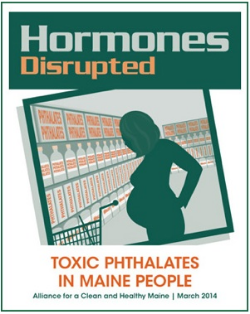I’m a label reader. Every trip to the store involves a careful assessment of what’s coming into my home and into the hands (and mouths) of my two young sons. I am probably more aware of chemical safety than the average consumer, as I have spent the last several years and transitioning away from goods that are likely to contain harmful chemicals to safer alternatives. I use glass instead of plastic food containers. I’ve swapped out the vinyl shower curtain for cloth. And I am thrilled every time I can see clear evidence that I’m avoiding the dangerous chemicals known to me, like the now common “BPA Free” labels on reusable water bottles.
I also know enough about our country’s broken chemical safety system to recognize that the information on labels is often incomplete – obscuring harmful chemicals in everyday products. And yet, I still wasn’t prepared for what I learned this week about the levels of phthalates in my body.
 I was one of 25 Mainers who volunteered to be part of a bio-monitoring study of phthalates (pronounced THAL-ates), a group of hormone-disrupting chemicals that are widely used in consumer products. We each provided urine samples which were tested for the presence of seven different phthalates. This week the results were released by the Alliance for a Clean and Healthy Maine in a report titled, “Hormones Disrupted: Toxic Phthalates in Maine People”.
I was one of 25 Mainers who volunteered to be part of a bio-monitoring study of phthalates (pronounced THAL-ates), a group of hormone-disrupting chemicals that are widely used in consumer products. We each provided urine samples which were tested for the presence of seven different phthalates. This week the results were released by the Alliance for a Clean and Healthy Maine in a report titled, “Hormones Disrupted: Toxic Phthalates in Maine People”.
The results made my jaw drop. Despite everything I’ve done to proactively protect my boys from harmful chemicals, I had the highest total level of phthalates in my body out of anyone in the group. My levels were higher than levels found in 90% of all Americans tested by the US Centers for Disease Control.
I was not alone in my exposure to phthalates. In fact, every single one of us had phthalates in our bodies. The 25 participants in the study come from both rural areas and cities, and include nurses, educators, scientists, a college student, an electrician, and a handful of current and former legislators from both sides of the aisle. Yet none of us escaped exposure to these harmful chemicals.
Where is my exposure coming from? The most frustrating thing for me, as a mother, is not being able to answer that question. If I am exposed to any chemical, my sons are probably exposed too. But complete information on the chemical content of products is almost non-existent, leaving me unable to protect myself and my loved ones.
Like most people, I use some products every day that might contain phthalates: hand soap, lotion, make up, etc. But my label reading doesn’t help me. Phthalates are never listed on the labels of these products. In fact, manufacturers use the term “fragrance” on a label to hide any number of chemicals, including phthalates, which might be in the product. So I am left in the dark.
I’ve learned that phthalates are used to soften vinyl plastic and are routinely added to hundreds of everyday products and building materials found in the home, including lunch boxes, kids’ backpacks, school supplies, rain coats and boots, shower curtains, tablecloths, floor tiles and wall coverings. But phthalates are never disclosed when purchasing these items.
As a mom with two young sons, the implications of my phthalate levels are really frightening. I know that these chemicals have adverse health effects on baby boys, including birth defects in male sex organs as well as reduced fertility and increased risk of prostate and testicular cancer later in life. I also know that phthalate exposure is linked to many of the issues that teachers like my mom and sister are seeing more and more of every day: learning disabilities, behavioral and attention issues, and asthma.
It seems criminal to me that consumers cannot see what is inside their products so that we can make rational decisions about our health and the health of our children.
The “Hormones Disrupted Report” presents a clear need for policy change. Even the most avid label-readers like me cannot shop our way out of this problem.
Here in Maine, citizens are using the state’s Kid Safe Products Act (2008) to take matters into their own hands. We are now circulating a citizen-led petition that will initiate a rulemaking before the Maine Department of Environmental Protection on the reporting of phthalates in consumer products.The rule would elevate four phthalates to “Priority Chemical” status under Maine’s Kid-Safe Products Act and require manufacturers to report on which of their products sold in Maine contains the priority phthalates. In other words, Mainers are taking action to find out which products contain phthalates.
While Mainers call on our state government to take this important first step that will get consumers needed information, we should also demand that Congress step up and pass real reform of the outdated Toxic Substances Control Act.
Current proposals before the U.S. House and Senate fall way short of ensuring that chemicals are proven safe before they end up in our products, and even threaten to strip away Maine’s authority to do the kind of information gathering we are advancing right now. This is unacceptable.
Participating in this study has been an eye-opening experience for me. I was always supportive of stronger protections from toxic chemicals. But actually seeing chemicals in my own body that are known to be extremely dangerous has transformed my interest in this topic into a fervent hope that we can change this broken system through action. No parent should have to worry that their kids could be exposed to harmful chemicals.




